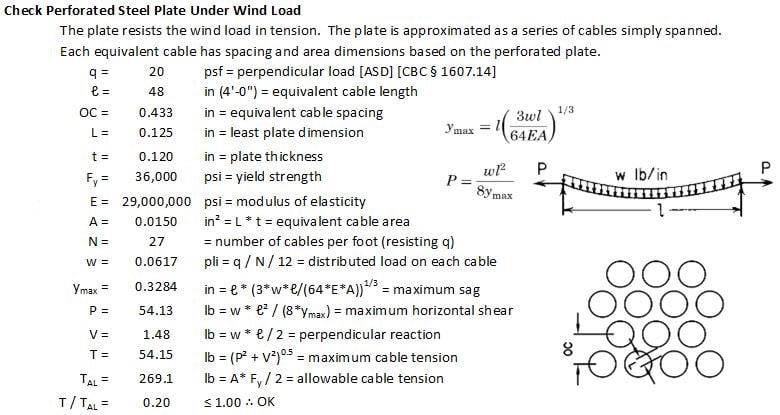JasonMcCool
Structural
- Apr 22, 2010
- 10
thread507-446756
Curious if anyone knows where forum member Dreber got the source he posted in the linked thread for checking the strength of perforated plates as a series of equivalent "cables" in tension under a uniform load. It appears the equation for ymax in his example portion of his post incorrectly has an uppercase L in place of a lowercase L based on the little screenshot of a formula and diagram included (attached is an edited screenshot with the correction). But my question is where that formula for max deflection of a cable under a uniform load in terms of span, load, cross-sectional area, and modulus of elasticity came from. I haven't found anything similar in any of my books or elsewhere online. Most references simply give cable deflection in terms of tension. With EA in there, I'm guessing this is accounting for cable stretch, but I'm having a hard time deriving it. Any ideas on a source or hints on derivation? Much thanks!

Curious if anyone knows where forum member Dreber got the source he posted in the linked thread for checking the strength of perforated plates as a series of equivalent "cables" in tension under a uniform load. It appears the equation for ymax in his example portion of his post incorrectly has an uppercase L in place of a lowercase L based on the little screenshot of a formula and diagram included (attached is an edited screenshot with the correction). But my question is where that formula for max deflection of a cable under a uniform load in terms of span, load, cross-sectional area, and modulus of elasticity came from. I haven't found anything similar in any of my books or elsewhere online. Most references simply give cable deflection in terms of tension. With EA in there, I'm guessing this is accounting for cable stretch, but I'm having a hard time deriving it. Any ideas on a source or hints on derivation? Much thanks!


